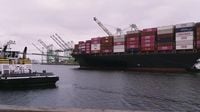As the clock ticks down to the August 1 deadline for the imposition of reciprocal tariffs by the United States, South Korea finds itself at a critical crossroads in trade negotiations that could reshape its economic landscape. The negotiations, marked by intense diplomatic activity and strategic maneuvering, are set to culminate in a pivotal meeting on July 31, 2025, between South Korea's Deputy Prime Minister Koo Yun-cheol and U.S. Treasury Secretary Scott Bessent in Washington.
The backdrop to these talks is the Trump administration's aggressive tariff policy, which has already imposed a 25% reciprocal tariff rate on South Korean goods. This move threatens to significantly impact South Korea's manufacturing sector, a vital engine of its economy. The stakes are high: failure to reach an agreement could inflict a blow more severe than that faced by Japan, which shares a similar export composition but secured a more favorable 15% tariff rate after agreeing to a substantial $5.5 billion investment package to the U.S.
Earlier plans for a '2+2 trade dialogue' involving Koo Yun-cheol and Trade Minister Yeo Han-gu on the Korean side, and Bessent alongside U.S. Trade Representative Jamie Harrison, were postponed by the U.S., underscoring the complexity and urgency of the situation. Nevertheless, South Korean officials have been steadfast in their efforts, with Industry Minister Kim Jung-kwan and Trade Minister Yeo Han-gu engaging in back-to-back meetings with U.S. Commerce Secretary Howard Lutnick and Harrison. Notably, these discussions extended late into the night at Lutnick's residence in New York, reflecting the high-pressure environment surrounding these talks.
The negotiation window is narrow. President Donald Trump, who visited Scotland on July 25, is scheduled to return to the U.S. on July 29. His agenda includes tariff discussions with the European Union on July 27 and a high-level trade meeting with China on July 28-29 in Sweden. These engagements mean that South Korea's face-to-face negotiation opportunities with the U.S. are effectively limited to July 30 and 31, making the upcoming meetings all the more consequential.
South Korea is deploying a two-track negotiation strategy. Minister Kim Jung-kwan focuses on manufacturing and energy sectors, advocating a 'package deal' encompassing increased U.S. investments, strategic industry cooperation, and participation in the Alaska LNG development project. Meanwhile, Minister Yeo Han-gu concentrates on agricultural market access, digital trade issues, and the contentious opening of beef and pork markets, which had previously been considered off-limits or 'red lines' in the talks.
Adding diplomatic heft to the negotiations, Foreign Minister Cho Hyun is slated to meet U.S. Secretary of State Marco Rubio on July 31 to bolster support for the trade talks. While not directly linked to tariff discussions, this meeting signals the intertwined nature of trade, security, and diplomatic relations, especially given the emphasis on shipbuilding and defense cooperation between the two nations.
The South Korean government is also contemplating expanding its existing investment plans beyond the 1 trillion won mark, partly in response to Japan's precedent of promising a $5.5 billion investment package to the U.S. in exchange for tariff concessions. Discussions include leveraging policy financial institutions to mobilize additional resources, aiming to meet or exceed U.S. expectations.
Behind the scenes, the U.S. is simultaneously engaged in intense negotiations with the European Union and China. President Trump’s meeting with Ursula von der Leyen, President of the European Commission, in Scotland is a key moment in finalizing a four-month-long trade negotiation, with both sides reportedly working toward a mutual tariff reduction to approximately 15%, mirroring the recent U.S.-Japan agreement. Similarly, the U.S. and China are preparing for their third high-level trade meeting in Sweden, with a negotiation deadline set for August 12, 2025.
Amid these global negotiations, South Korea's position is precarious. The imposition of a 25% tariff threatens to undermine its manufacturing sector's competitiveness, particularly as Japan has already secured a more favorable deal. The inclusion of agricultural products such as rice and beef on the negotiation table marks a significant shift, as these were once considered non-negotiable. This development reflects the U.S.'s heightened demands and the Korean government's willingness to explore new avenues to avert economic damage.
Domestic headlines in South Korea echo the gravity of the situation, with terms like 'week of destiny' and 'all-out war' frequently used to describe the negotiation period. Media outlets highlight the strategic use of South Korea's shipbuilding industry as a bargaining chip, the government's efforts to defend a 15% tariff ceiling, and the broader implications for the nation's export-driven economy.
As the July 31 meeting approaches, all eyes are on Deputy Prime Minister Koo and Treasury Secretary Bessent to deliver a breakthrough. The outcome will not only determine the immediate tariff rates but also set the tone for South Korea's trade relations with the U.S. amidst a shifting global economic order. With limited time and high stakes, the negotiations represent a defining moment for South Korea's economic future.

